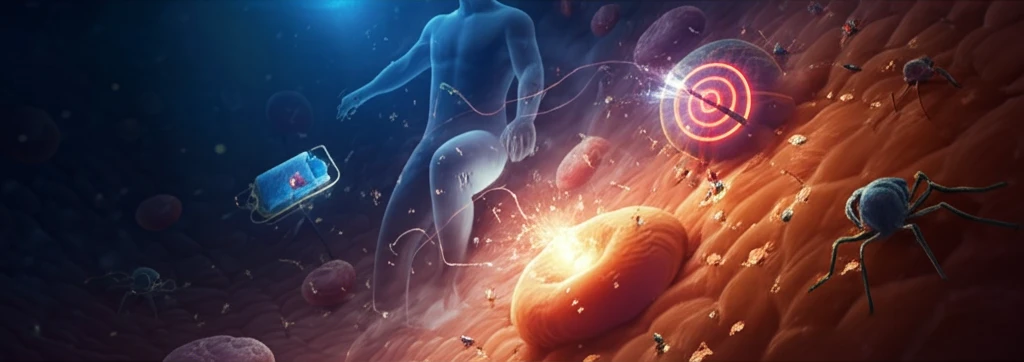
Hybrid Nanostructures: The Tiny Tech Revolutionizing Cancer Treatment
"Explore how hybrid nanostructures are emerging as innovative tools in cancer theranostics, offering new hope for targeted and effective treatments."
Imagine tiny tools, so small they can navigate the human body to repair damage at a cellular level. This isn't science fiction anymore. Hybrid nanostructures – complex materials engineered at the nanoscale – are rapidly advancing as a new frontier in cancer treatment. Combining the best properties of organic and inorganic materials, these structures offer unprecedented potential for both diagnosing and treating cancer with greater precision and effectiveness.
For decades, cancer treatment has relied on methods like chemotherapy and radiation, which, while effective, often cause significant side effects due to their impact on healthy cells. The promise of nanomedicine lies in its ability to target cancer cells directly, minimizing damage to surrounding tissues and improving patient outcomes. Hybrid nanostructures are at the forefront of this revolution, offering a versatile platform for delivering drugs, imaging tumors, and even stimulating therapeutic responses directly within the cancer cells.
This article explores the exciting world of hybrid nanostructures, delving into their potential to revolutionize cancer treatment while also acknowledging the challenges that remain in translating these technologies from the lab to the clinic. We'll examine their strengths, limitations, and the future prospects of this groundbreaking field.
The Promise of Hybrid Nanostructures: A New Era in Cancer Theranostics

Hybrid nanostructures are essentially tiny assemblies that combine different types of materials at the nanoscale (one billionth of a meter). This allows scientists to create structures with customized properties, optimized for specific tasks in cancer theranostics – the simultaneous diagnosis and treatment of disease.
- Target cancer cells with pinpoint accuracy, delivering drugs directly to the tumor while sparing healthy tissues.
- Provide real-time imaging of tumors, allowing doctors to monitor the effectiveness of treatment and adjust strategies as needed.
- Deliver multiple therapeutic agents simultaneously, attacking cancer cells from different angles to overcome resistance.
- Respond to specific stimuli within the tumor environment, such as acidity or specific enzymes, triggering drug release or therapeutic action only when and where it's needed.
Looking Ahead: Overcoming the Challenges and Realizing the Potential
While the potential of hybrid nanostructures in cancer treatment is immense, significant challenges remain in translating these technologies from the laboratory to widespread clinical use. Issues such as scalable manufacturing, biocompatibility, long-term toxicity, and the complexity of biological systems need to be addressed before hybrid nanostructures can become a mainstream cancer therapy. However, with continued research and collaboration between scientists, engineers, and clinicians, the future of cancer treatment is poised to be transformed by these tiny, yet powerful tools.
